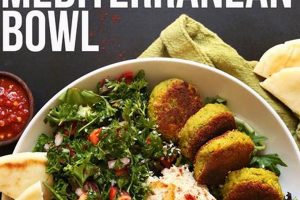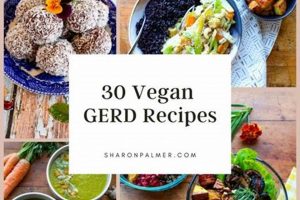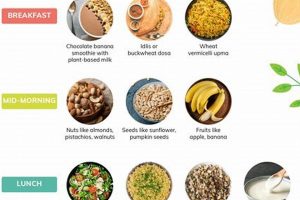The intersection of plant-based eating and gastroesophageal reflux disease presents a complex relationship. A dietary approach focused solely on plant-derived foods may, in some instances, alleviate symptoms of acid reflux due to the inherent lower fat content found in many plant-based meals and the potentially higher fiber intake. Conversely, certain components commonly included within this nutritional strategy, such as tomatoes, citrus fruits, or high-fat plant-based alternatives, could exacerbate symptoms in susceptible individuals.
Understanding the impact of nutritional choices on digestive health is crucial for individuals managing acid reflux. Historically, dietary modifications have been a cornerstone of managing the condition, often preceding or complementing pharmaceutical interventions. The potential advantages of a plant-centered approach lie in its ability to reduce reliance on animal products, which can be triggers for some. A thoughtfully planned approach could offer a sustainable, long-term strategy for symptom management and overall well-being.
The following sections will explore the specific foods, nutritional considerations, and potential challenges associated with using plant-based eating in the context of this digestive disorder, offering a balanced perspective on its application as a therapeutic dietary intervention.
Practical Considerations for Plant-Based Eating and Acid Reflux
Implementing a plant-based approach requires careful planning to mitigate potential reflux triggers and ensure nutritional adequacy. The following tips offer guidance in navigating this dietary strategy effectively.
Tip 1: Prioritize Low-Acid Fruits and Vegetables: Opt for non-citrus fruits, such as melons and bananas, and alkaline vegetables like leafy greens, broccoli, and green beans. These are generally less likely to provoke reflux episodes.
Tip 2: Manage Fat Intake: High-fat foods can delay gastric emptying and increase the risk of reflux. Choose lean plant-based protein sources and limit the consumption of fried or excessively oily vegan dishes.
Tip 3: Cook with Soothing Herbs and Spices: Ginger, turmeric, and chamomile possess anti-inflammatory properties that may aid in digestion and reduce reflux symptoms. Incorporate these into meals and beverages.
Tip 4: Portion Control is Essential: Consuming smaller, more frequent meals can help prevent overeating and reduce pressure on the lower esophageal sphincter, thereby minimizing the likelihood of acid reflux.
Tip 5: Identify and Avoid Personal Trigger Foods: Keep a food diary to track meals and associated symptoms. Common plant-based triggers may include tomatoes, chocolate, caffeine, and spicy peppers. Elimination and subsequent reintroduction can help pinpoint individual sensitivities.
Tip 6: Mindful Eating Practices: Eating slowly, chewing food thoroughly, and avoiding distractions can enhance digestion and reduce the risk of reflux. Practice mindful eating techniques to promote better gut health.
Tip 7: Consider Food Preparation Methods: Opt for baking, steaming, or grilling over frying. These cooking methods minimize added fats and reduce the potential for triggering reflux.
Implementing these practical steps can help individuals successfully navigate a plant-based dietary regimen while effectively managing acid reflux symptoms, leading to improved digestive comfort and overall well-being.
The following sections will explore advanced strategies and potential challenges in adopting a long-term plant-based approach for acid reflux management.
1. Dietary Fiber Content
Dietary fiber plays a dual role in the context of plant-based eating and gastroesophageal reflux disease. While generally considered beneficial for digestive health, its impact on acid reflux symptoms can be variable and dependent on individual tolerance and the specific types of fiber consumed. The quantity and solubility of fiber in plant-based foods warrant careful consideration for those managing the condition.
- Soluble Fiber and Gastric Emptying
Soluble fiber, found in foods like oats, beans, and apples, absorbs water in the digestive tract, forming a gel-like substance. This can slow gastric emptying, which may reduce postprandial reflux by limiting the volume of stomach contents available for regurgitation. However, delayed gastric emptying can also lead to increased abdominal pressure and distension, potentially worsening reflux symptoms in certain individuals.
- Insoluble Fiber and Esophageal Motility
Insoluble fiber, prevalent in whole grains and vegetables, adds bulk to the stool and promotes regular bowel movements. While this aids in overall digestive function, high intakes of insoluble fiber can occasionally irritate the esophageal lining in those with pre-existing inflammation. Maintaining adequate hydration is essential when consuming substantial amounts of insoluble fiber to prevent constipation and associated discomfort.
- Fermentable Fiber and Gas Production
Certain types of fiber, particularly those found in legumes and cruciferous vegetables, are highly fermentable by gut bacteria. This fermentation process can lead to increased gas production, causing bloating and abdominal discomfort. Elevated intra-abdominal pressure from gas can exacerbate reflux symptoms by weakening the lower esophageal sphincter. Careful selection and preparation of these foods can help minimize gas production.
- Fiber and Lower Esophageal Sphincter Pressure
The relationship between fiber intake and lower esophageal sphincter (LES) pressure is complex. While some studies suggest that increased fiber intake may improve LES function, others indicate that certain high-fiber foods can reduce LES pressure, potentially contributing to reflux. Individual responses can vary significantly, necessitating personalized dietary adjustments based on symptom monitoring.
The impact of dietary fiber on acid reflux is nuanced and highly individual. Individuals employing plant-based eating for managing gastroesophageal reflux disease should carefully monitor their symptoms in response to varying fiber types and quantities. Gradual increases in fiber intake, adequate hydration, and mindful food selection are essential strategies for optimizing digestive comfort and minimizing potential adverse effects. Tailoring fiber intake to individual tolerance levels is essential for maximizing the benefits and minimizing the risks.
2. Trigger Food Identification
The identification of trigger foods is a cornerstone of effectively managing gastroesophageal reflux disease, particularly within the context of plant-based eating. While adopting a vegan diet may inherently reduce exposure to certain refluxogenic substances found in animal products, it does not guarantee symptom alleviation. Specific plant-derived items can exacerbate reflux due to their inherent properties or the manner in which they are prepared. Failure to identify and eliminate these triggers can undermine the potential benefits of a plant-centered dietary approach.
The mechanism by which certain foods trigger reflux varies. Some foods, such as tomatoes and citrus fruits, possess high acidity that can directly irritate the esophageal lining. Others, like chocolate and caffeine, can relax the lower esophageal sphincter, increasing the likelihood of acid escaping into the esophagus. High-fat plant-based options, such as fried foods or dishes rich in oils, can delay gastric emptying, prolonging the period during which reflux can occur. Common examples include spicy vegan chili, tomato-based pasta sauces, and heavily processed plant-based meats. A meticulous approach involving food diaries and elimination diets is often necessary to pinpoint individual sensitivities. A structured process can transform a potentially haphazard approach into a well-managed dietary strategy.
Successfully navigating plant-based eating while managing gastroesophageal reflux disease requires a commitment to identifying and avoiding personalized trigger foods. This proactive strategy is essential for realizing the potential benefits of a plant-centered dietary approach in mitigating reflux symptoms. Overlooking this critical step can negate the advantages of a plant-based regimen, emphasizing the need for a tailored, informed approach to dietary management. The meticulous identification of specific triggers is crucial for long-term symptom management and overall well-being.
3. Nutrient Adequacy
Maintaining adequate nutrient intake within a plant-based dietary framework, particularly in individuals managing gastroesophageal reflux disease, presents a multifaceted challenge. The restrictive nature of both a plant-based diet and the dietary modifications often recommended for acid reflux can increase the risk of nutrient deficiencies if not carefully planned. Inadequate intake of essential nutrients can, in turn, exacerbate existing health conditions and potentially impair the body’s ability to manage acid reflux symptoms effectively.
The dietary restrictions commonly advised for acid reflux, such as avoiding acidic foods, spicy seasonings, and high-fat meals, can overlap with nutrient-dense plant-based food sources. For instance, tomatoes, often limited due to their acidity, are a significant source of Vitamin C and lycopene. Similarly, while high-fat foods may trigger reflux, certain plant-based fats are crucial for absorbing fat-soluble vitamins. Therefore, a strategically planned plant-based dietary approach is vital to ensure sufficient intake of nutrients such as Vitamin B12, iron, calcium, Vitamin D, omega-3 fatty acids, and zinc. For example, individuals might need to supplement Vitamin B12, readily found in animal products but not naturally occurring in plant foods, or consume fortified plant-based alternatives.
Proper nutritional planning, including potential supplementation, becomes especially critical for vulnerable populations, such as pregnant women, children, and the elderly, all of whom have heightened nutritional needs. By carefully considering food choices, incorporating nutrient-dense plant-based options, and monitoring nutrient levels through blood tests, individuals following a plant-based diet can effectively manage acid reflux symptoms while maintaining optimal nutritional status. Failure to address nutrient adequacy can lead to unintended consequences, undermining the long-term health benefits of a plant-centered dietary strategy.
4. Meal Timing Impact
The timing of meals exerts a significant influence on the manifestation and management of gastroesophageal reflux disease, particularly within the framework of plant-based dietary patterns. Strategic scheduling of food consumption, taking into account meal size and composition, can either mitigate or exacerbate reflux symptoms. Understanding the interplay between meal timing and gastric physiology is crucial for individuals adopting plant-based eating to manage this digestive disorder.
- Late-Night Eating and Nocturnal Reflux
Consuming meals close to bedtime increases the likelihood of nocturnal reflux episodes. When lying down, gravity no longer assists in keeping stomach contents in the stomach, facilitating the regurgitation of gastric acid into the esophagus. Individuals following plant-based regimens should avoid eating at least three hours before lying down to minimize this risk. A lighter evening meal consisting of easily digestible foods is also advisable.
- Meal Frequency and Gastric Acid Production
The frequency of meals can influence the overall production of gastric acid. Large, infrequent meals can lead to prolonged periods of high acid secretion, increasing the risk of reflux. Conversely, smaller, more frequent meals can help maintain a more stable gastric pH level. Adopting this strategy can be particularly beneficial for those on a plant-based regimen, as it may help moderate the impact of potentially triggering foods.
- Postprandial Posture and Esophageal Clearance
Maintaining an upright posture after eating aids in esophageal clearance, the process by which the esophagus clears any refluxed material back into the stomach. This is particularly important after meals that include potentially refluxogenic plant-based foods. Individuals should remain upright for at least 30 minutes after eating to facilitate this process.
- Meal Composition and Gastric Emptying Rate
The composition of a meal, including its fat, protein, and carbohydrate content, can significantly affect gastric emptying rate. High-fat meals, even from plant-based sources, tend to slow gastric emptying, increasing the time during which reflux can occur. Plant-based meals that are lower in fat and higher in fiber may promote more rapid gastric emptying, potentially reducing reflux episodes. However, very large meals can also delay gastric emptying, irrespective of their composition.
Strategic manipulation of meal timing offers a valuable tool for managing gastroesophageal reflux disease within a plant-based dietary context. By carefully considering the timing, frequency, and composition of meals, individuals can optimize their digestive health and minimize the occurrence of reflux symptoms. Ignoring these factors may negate the potential benefits of a plant-centered dietary approach, underscoring the importance of a holistic approach to dietary management.
5. Inflammation Reduction
The potential for inflammation reduction constitutes a significant aspect of the relationship between plant-based eating and gastroesophageal reflux disease. Chronic inflammation within the digestive tract can exacerbate reflux symptoms by compromising esophageal motility, increasing sensitivity to gastric acid, and disrupting the function of the lower esophageal sphincter. Dietary strategies that mitigate systemic and local inflammation may, therefore, play a role in managing the condition.
Plant-based diets, rich in antioxidants, phytonutrients, and fiber, offer a potential pathway for reducing inflammation. Antioxidants, abundant in fruits and vegetables, neutralize free radicals that contribute to oxidative stress and inflammation. Phytonutrients, bioactive compounds found in plants, possess anti-inflammatory properties, modulating inflammatory pathways within the body. Fiber promotes a healthy gut microbiome, which plays a crucial role in regulating inflammation throughout the digestive system and beyond. Conversely, certain animal products, particularly processed meats and high-fat dairy, can promote inflammatory responses. The replacement of these foods with anti-inflammatory plant-based alternatives may help to alleviate reflux symptoms associated with inflammation.
While the anti-inflammatory potential of plant-based eating is promising, individual responses can vary considerably. Certain plant-derived foods can trigger inflammation in sensitive individuals. Moreover, the overall nutritional adequacy of a plant-based diet is essential for optimal immune function and inflammation control. Successfully harnessing the anti-inflammatory benefits of plant-based eating for managing gastroesophageal reflux disease requires a careful approach, incorporating diverse nutrient-rich plant foods, identifying and avoiding individual triggers, and ensuring overall dietary balance. Proper implementation can reduce inflammation, improve symptoms, and enhance quality of life.
Frequently Asked Questions
The following questions address common concerns and misconceptions regarding plant-based dietary approaches for managing gastroesophageal reflux disease. The information provided is intended for educational purposes and does not constitute medical advice. Consultation with a qualified healthcare professional is essential before making significant dietary changes.
Question 1: Is a plant-based regimen inherently beneficial for acid reflux?
A plant-based dietary approach is not inherently beneficial. While it may offer advantages due to the reduction of animal products, specific plant-derived foods can trigger reflux symptoms. Careful food selection and individualized dietary modifications are essential.
Question 2: Which plant-based foods are most likely to trigger acid reflux?
Common plant-based triggers include tomatoes, citrus fruits, chocolate, caffeine, and high-fat foods, even those derived from plant sources. Individual sensitivities vary; therefore, systematic identification through food diaries is recommended.
Question 3: How can nutrient deficiencies be avoided on a plant-based diet for acid reflux?
Nutrient deficiencies can be avoided through strategic meal planning, prioritizing nutrient-dense plant foods, and considering supplementation. Consultation with a registered dietitian is advisable to ensure adequate intake of Vitamin B12, iron, calcium, Vitamin D, omega-3 fatty acids, and zinc.
Question 4: Does the timing of meals impact reflux symptoms within a plant-based framework?
The timing of meals significantly influences reflux symptoms. Eating late at night should be avoided. Consuming smaller, more frequent meals is preferable. Maintaining an upright posture post-meal is also recommended to facilitate esophageal clearance.
Question 5: Can a plant-based approach reduce inflammation associated with acid reflux?
A plant-based approach may reduce inflammation due to the abundance of antioxidants and phytonutrients in plant foods. However, individual responses vary, and certain plant-derived foods can be inflammatory in susceptible individuals. A balanced and diverse diet is essential.
Question 6: Are processed plant-based meats a healthy option for individuals with acid reflux?
Processed plant-based meats are not necessarily a healthy option. These products can be high in fat, sodium, and additives, which may exacerbate reflux symptoms. Prioritizing whole, unprocessed plant foods is generally preferable.
Effective management of acid reflux through a plant-based diet requires a nuanced and individualized approach. It is crucial to recognize the potential benefits and challenges, carefully select appropriate foods, and address any nutritional deficiencies. Consulting healthcare professionals is always recommended.
The subsequent section will explore advanced strategies for those seeking long-term adherence to a plant-based diet while effectively managing gastroesophageal reflux disease.
vegan diet and gerd
This exploration of plant-based eating and gastroesophageal reflux disease has illuminated the complexities of this intersection. Key considerations include the dual role of dietary fiber, the critical importance of identifying personal trigger foods, the necessity of ensuring nutrient adequacy, the impact of meal timing on symptom manifestation, and the potential for inflammation reduction through strategic food choices. Successfully navigating this dietary approach demands a personalized, informed strategy that goes beyond simply eliminating animal products.
The information presented underscores the importance of individualized dietary management for those with acid reflux. Long-term adherence to a plant-based plan, when thoughtfully implemented, may offer a sustainable path toward symptom management and improved well-being. Further research is needed to fully elucidate the nuances of this relationship and refine dietary recommendations. A proactive approach, involving close collaboration with healthcare professionals, remains essential for optimizing outcomes and ensuring long-term health.







